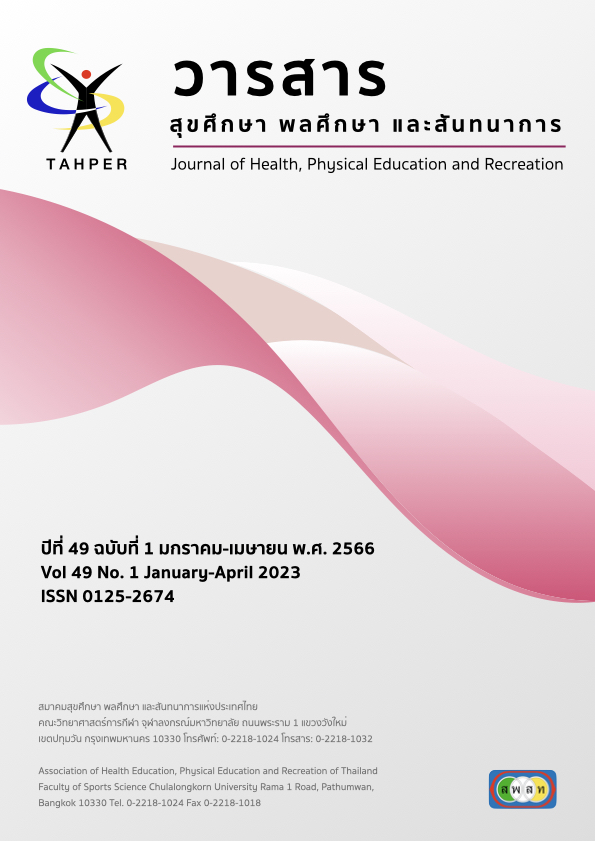Effects of Circuit Thai Folk Game Program on Physical Fitness and Agility of Students in the Grade 1 at Banbangkapi School
Main Article Content
Abstract
The purpose of this quasi-experiment research was to study the effects of circuit Thai folk game programs on physical fitness and agility of students in the grade 1 at Banbangkapi School. The sample were 84 grad 1 students who enrolled in the second semester of the academy year 2020 at Banbangkapi School. The samples were obtained by cluster random sampling and were randomly divided into 2 groups: the experimental group and the control group. The experimental group were participated the 8 weeks of the circuit Thai folk game programs created by researcher and considered for content validity by 5 experts. The control group were participated 8 weeks of the regular physical education class. The physical fitness test for Thai children youth and Thai people and physical fitness test for Thai children (Agility Test) created by office of sport science, Department of Physical Education, Ministry of Tourism and Sports were tested during the first week and 8 weeks of the experimental. The data were analyzed by mean, standard deviation and Paired Sample t-test and independent t-test.
The results showed that after 8 weeks of participating the circuit Thai folk game programs, the average of body mass index, sit and reach, 30 seconds modified push-up, 3 minutes step up and down, and shuttle and zig-zag run of the experimental group were significantly better than before at the .05 level. And the average of sit and reach, 30 seconds modified push-up, 3 minutes step up and down, of the experimental group and the control groups were significantly difference at the .05 level but the body composition and shuttle and zig-zag run were not different.
Keywords: Physical Fitness, Agility, Thai folk game, Circuit Training
Article Details

This work is licensed under a Creative Commons Attribution-NonCommercial-NoDerivatives 4.0 International License.
Critical thinking in journals is the right of the author. The Association of Health Education, Physical Education and Recreation of Thailand is not always required, to create diversity in ideas and creativity.
ความคิด ข้อวิพากษ์ในวารสารเป้นสิทธิของผู้เขียน สมาคมสุขศึกษา พลศึกษา และสันทนาการแห่งประเทศไทยไม่จำเป็นต้องเห็นชอบด้วยเสมอไป เพื่อให้เกิดความหลากหลายในความคิดและความสร้างสรรค์
References
กระทรวงศึกษาธิการ. (2551). หลักสูตรแกนกลางการศึกษาขั้นพื้นฐานพ.ศ. 2551. กรุงเทพฯ: สุวิริยาสาส์น.
เจริญ กระบวนรัตน์. (2561). วิทยาศาสตร์การฝึกสอนกีฬา (พิมพ์ครั้งที่ 2). กรุงเทพฯ: สินธนาก๊อปปี้เซนเตอร์.
ผะอบ โปษะกฤษณะ และคณะ. (2545). การละเล่นของไทย. สารานุกรมไทยสำหรับเยาวชนฯ ฉบับอิเล็กทรอนิคส์ โครงการสารานุกรมไทยสำหรับเยาวชนฯ. สืบค้น 25 กรกฎาคม 2564, จาก https://www.saranukromthai.or.th/sub/Ebook/Ebook.php?book=13
ราชวิทยาลัยกุมารแพทย์แห่งประเทศไทย. (2560). คู่มือสำหรับพ่อแม่ เพื่อเผยแพร่ความรู้ด้านการดูแลและพัฒนาเด็ก ตอน เด็กวัยเรียน 6-12 ปี. กรุงเทพฯ: ราชวิทยาลัยกุมารแพทย์แห่งประเทศไทย สมาคมกุมารแพทย์แห่งประเทศไทย.
วรวุฒิ หวังสุข. (2563). ผลของโปรแกรมการฝึกการเคลื่อนไหวแบบผสมผสานผ่านการใช้เทคโนโลยีรหัสคิวอาร์ที่มีต่อความคล่องแคล่วว่องไว ของนักเรียนระดับชั้นประถมศึกษาปีที่ 3โรงเรียนสาธิตแห่งมหาวิทยาลัยเกษตรศาสตร์ ศูนย์วิจัยและพัฒนาการศึกษา (วิทยานิพนธ์ปริญญามหาบัณฑิต). กรุงเทพฯ: มหาวิทยาลัยเกษตรศาสตร์.
ศิริพร หน่อไชย. (2549). ผลของการฝึกความแข็งแรงกล้ามเนื้อลำตัวบนพื้นและบนลูกบอลออกกำลังกายต่อความแข็งแรงของกล้ามเนื้อท้องและความคล่องแคล่วว่องไวในนักเรียนชั้นประถมศึกษาปีที่ 1 (วิทยานิพนธ์ปริญญามหาบัณฑิต). กรุงเทพฯ: มหาวิทยาลัยเกษตรศาสตร์.
สำนักนันทนาการ กรมพลศึกษา. (2560). การละเล่นพื้นบ้านไทย. กรุงเทพฯ: กู๊ดอีฟนิ่งติงค์.
สำนักวิทยาศาสตร์การกีฬา กรมพลศึกษา. (2555). แบบทดสอบและเกณฑ์มาตรฐานสมรรถภาพทางกาย สำหรับเด็กไทย อายุ 4 – 6 ปี. กรุงเทพฯ: สัมปชัญญะ.
สำนักวิทยาศาสตร์การกีฬา กรมพลศึกษา. (2562). แบบทดสอบเกณฑ์มาตรฐานสมรรถภาพทางกาย ของเด็ก เยาวชน และประชาชนไทย. กรุงเทพฯ: เวิลด์ เอ็กซ์เพิร์ท.


